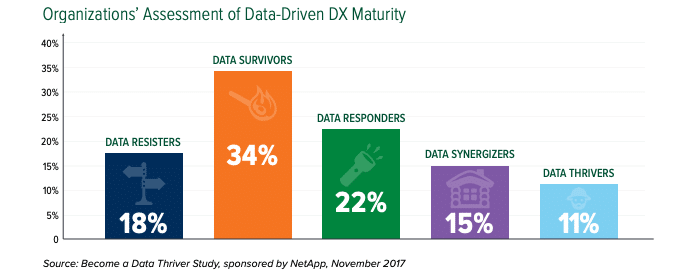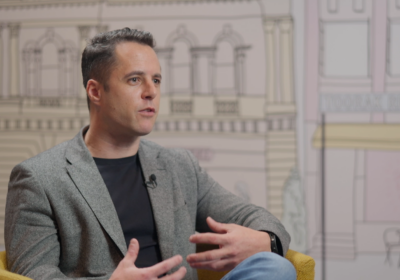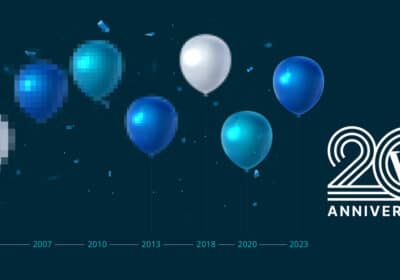When Jean English joined NetApp in 2016, she was set to “write a new story” for the tech company. She was brought on board in August 2016 by CEO George Kurian to help shift thinking about the company from a provider of data storage equipment to a company that provides full data services on the cloud.
But the first meeting to show her ideas not promising. NetApp’s customer advisory board had its own ideas of what was the story to tell, and “I thought they were going to throw tomatoes at me,” said English, who had joined the company from IBM, where she had overseen the transformation of its cloud computing business
She regrouped and set out to figure out what was the company’s purpose, and brought together top officials from the CEO to the head of sales, to help write a new story about the company’s move to the “hybrid cloud,” an environment that mixes solutions to offer the best data management. Telling that story has been English’s job for the last three years.
“We didn’t call it a digital transformation. and we didn’t call it a total rebranding, but that’s honestly what we started to embark on,” said English.
English spoke to Velocitize about the challenges of writing that new story, getting buy-in and dealing with turf and silos.
Velocitize: Coming in from outside the company and trying to change the image is a tall order. What was your biggest challenge, getting buy-in from all the departments, or crafting that new image?

We knew where we wanted to go in terms of a story or direction, but the output of that stayed within the marketing team. It turned into a marketing campaign. It turned into messaging for only the website. It became a brand, your advertising campaign, but it did not really flow through to the strategy of the company.
It has to go so much deeper to that into the whole company for it to really come to life. So my biggest hurdle was the breaking out of marketing as a marketing campaign and more marketing as a strategic thinker and member of the CEO staff to go across the company, so it wasn’t just a marketing transformation, it was a business transformation.
Things have also changed among your clients. Data used to be IT’s turf, and now everybody gets a say. How does that complicate your work?
Jean English: It was literally within the first couple weeks that I was at NetApp that I went to this customer advisory board that I talked about and they said: “You need to sell my boss, because I might not be in the room anymore to make those decisions.”
You need a new champion for that app and that new champion was the CIO, it was the cloud architects, and it was people that were thinking broader than what was just happening inside of the data center itself and just inside of the infrastructure technologies. So part of the the breakthrough that we’ve been really focused on is: How do you start to shift that conversation more to what the real problem is.
The problem isn’t storage. People don’t wake up every morning and say “I have a problem with my storage.” They say “Our problem with the data.”
I have to make sure that data flows through every single thing that we can do from the time a customer comes online to what they search on to how they may interact with us on the site to what they do off site, to what they might do when they actually do talk to a sales rep and what that conversation is: Does a sales rep then know what they actually did with us? Did we know all the way along that full sales journey?
That whole journey has to be connected. When we talk about the tribe, the champions have got to be champions for how NetApp is different. We’re bold, we can help customers in hybrid cloud environments. We can help them with their digital transformations, and not just that it’s a digital transformation, but it’s data-driven. We’re a different company and so we have to be seen differently. We have to think about how we help people to understand how it can help them now in more ways than ever before.
Data can be an abstract concept. How do you make it relevant?
Jean English: We did a big study called the Data Thriver Study. We went out with IDC and interviewed over 700 companies around the world, across industries. What we found is that the companies that really got it right, got it right. They made sure that data quality was high. They made sure that the data could be coming throughout the company; it wasn’t in silos.
The ones that did really well had really big results. We were seeing that the acquisition costs were lower, that their profitability was higher, margins were greater. But those were, not a lot of people. I mean, it was a slim number that was really getting it right; it was less than 20%.

Most of them, like 34% of the people that we interviewed, were just surviving with data and usually it was super ad-hoc. There were silos all over the place. Quality was on the radar, but they weren’t focused on the quality of the data and keeping it clean and they didn’t have someone that was really looking at it across the business.
That report has helped us to be able to talk about this message of a data driven digital transformation. That’s what has been really our full message going out into the market: As we think about the fact that we’re rebranding the company as a data authority and hybrid cloud, we can really help you enable your customers with their own digital transformations.
When we say “write the story,” that’s part of that story–facts and data about customers that we’re helping that are seeing big results. All of that starts to come together in terms of how we’re going out externally and publicly.
So if companies still have a long way to go with data, how can they use it to improve their customer experience?
Jean English: I don’t think companies can say that they’re customer focused if they don’t create a better user experience. It’s not just about saying “We care about our customers” or “We create great products for our customers.” Companies really have to think about what is that experience and those people want that to be seamless and frictionless.
What I’ve experienced is that you can create a lot of demand and energy and interest around how your company can help with a certain use case or how they think about the cloud, and then you get into a trial and it breaks, the trial is clunky or the trial on the back end doesn’t work. As a CMO I feel that it is my responsibility and accountability to the company to make sure that we’re thinking through that full user experience.
It is such a journey. It’s never perfect; I think the key is that our work is far from being done. But my message to the whole company, to my team, to customers that I see every day is: be bold. Taking the bold risk and breaking out of that comfort zone is a good thing.





Join the conversation